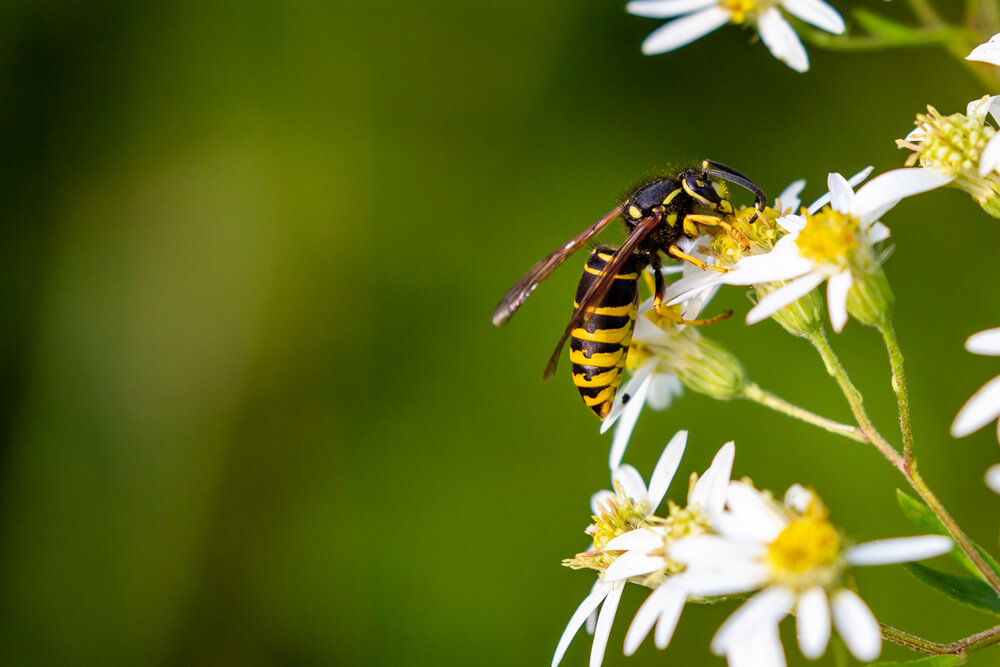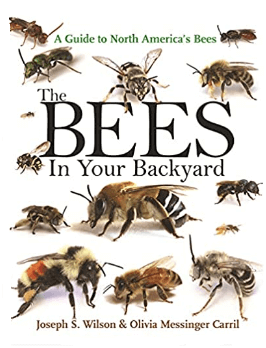Table of Contents:
What Are Black and Yellow Wasps?
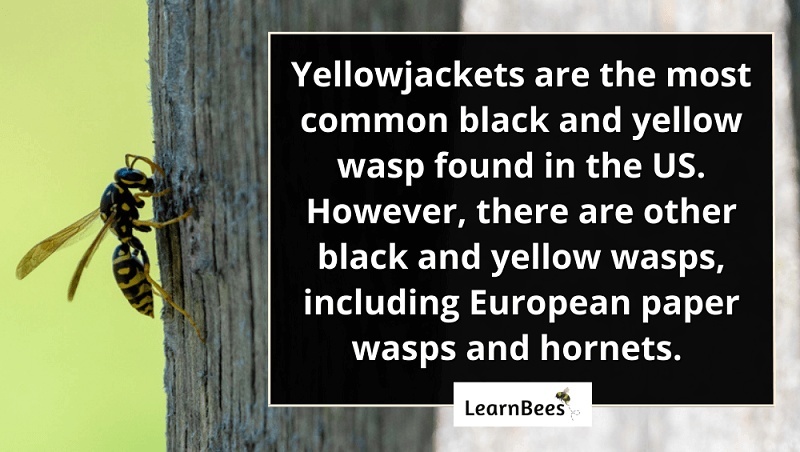
Black and yellow wasps include yellowjackets, paper wasps, and hornets.
That said, yellowjackets (Vespula maculifrons) are the most common black and yellow wasp we see in the United States.
And here’s the thing:
People usually associate yellowjackets with aggressive, stinging insects that attack everyone in sight.
Questions like “Are yellowjackets poisonous?” and “How do I kill yellowjackets?” are common google searches.
The truth, though?
Yellowjackets are important parts of our ecosystems.
Wait, let me rephrase that.
Yellowjackets are necessary parts of our ecosystems. Without them, we’d be in big trouble.
We rely on wasps to help control invasive bug populations and pollinate many foods we enjoy. For instance, wasps eat non-native bugs like lanternflies and emerald ash borers.
As a result, ecologists commonly release wasps to control pests that destroy plants, harm local habitats, and affect our food supply.
Take ash trees, for example.
Ash trees are threatened by emerald ash borers (Agrilus planipennis).
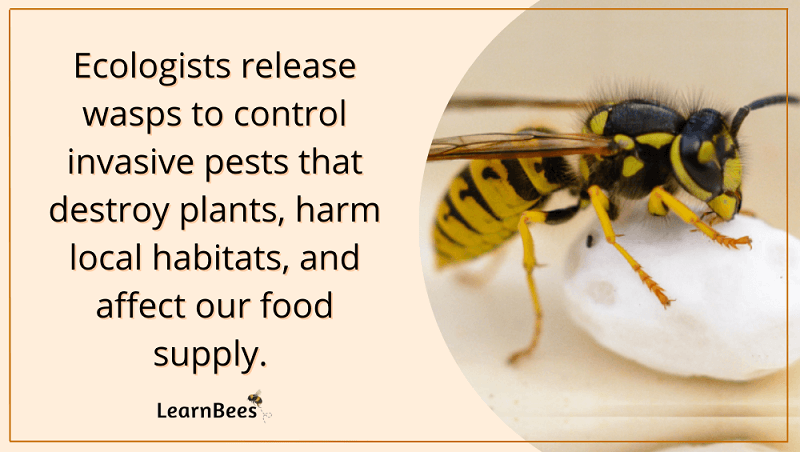
The emerald ash borer is a green, shiny beetle native to Asia. They were imported to North America in the early 2000s. Unfortunately, these beetles kill ash trees by tunneling into the bark and feeding on the nutrients.
The good news?
Wasps have been released to kill these invasive species. In turn, this is helping to restore ash forests and stop the spread of this harmful beetle.
What’s more:
Yellowjackets are valuable to farmers because they kill crop-eating pests. Cabbage worms, aphids, and beetle grubs cause severe damage to vegetables and fruits.
Without yellowjackets and other wasps, our food crops would be overrun with bugs.
So, to put it bluntly?
Wasps should be highly valued like bees are.
In fact, over 150 plant species are completely dependent on wasps for pollination. Some orchid species have even evolved special tricks to entice wasps. One example is orchids that draw male wasps in by mimicking the smell and look of female wasps.
And if that wasn’t enough:
Researchers believe that yellowjacket wasp venom contains ingredients that can prevent antimicrobial diseases and kill cancer cells.(1, 2)
As we learn more about wasps, the more we realize just how crucial they are.
Do Black and Yellow Wasps Sting?
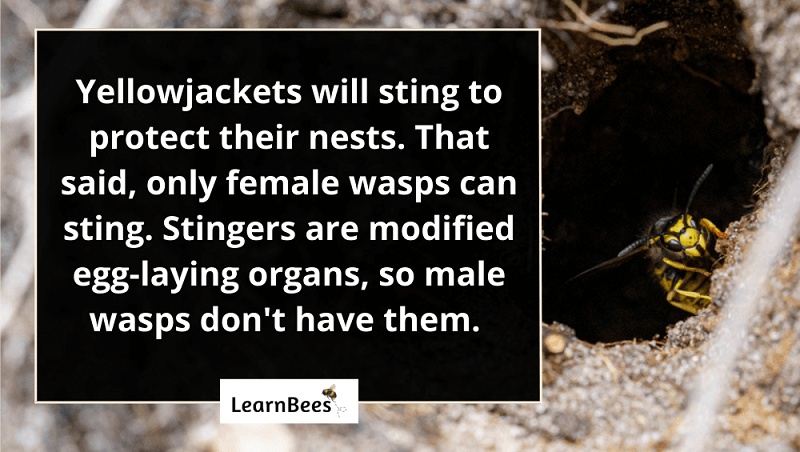
Black and yellow wasps (yellowjackets) sting to protect their nests.
Yellowjackets build their nests underground in tree stumps, hollow logs, or empty rodent holes. They’re social creatures, which means they live in colonies with other wasps.
But despite popular belief:
Yellowjackets don’t typically sting for no reason.
Usually, they only sting to defend their nest. However, yellowjacket nests can be tricky to see because they’re concealed underground or in vegetation piles. Sometimes you don’t realize you’re near a nest until you get stung.
And here’s the thing:
Yellowjacket wasps are often mistaken for honey bees because they have similar coloring and size.
However, wasps and bees aren’t the same.
Yellowjackets can be identified by their brightly colored bodies. They have vibrant yellow and black stripes with little hair on their bodies. Honey bees have amber and black stripes with noticeable fuzz near their heads.
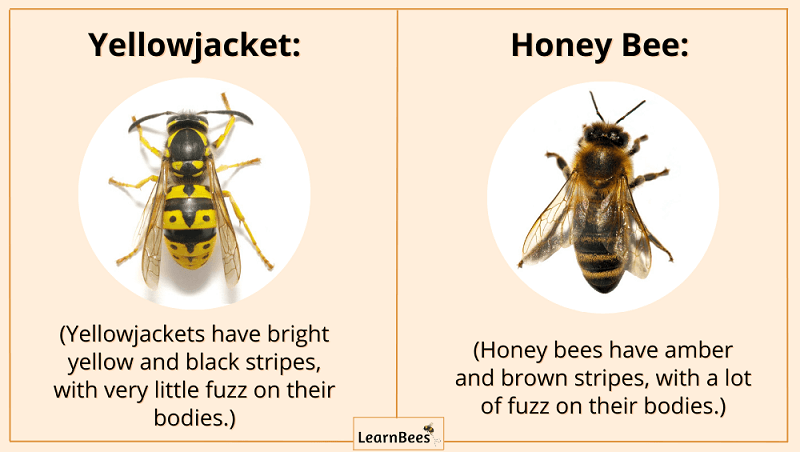
Honey bees, which also sting, live in social colonies aboveground. Honey bees tend to be less protective than yellowjackets, but they will sting if threatened.
Now here’s the interesting part:
Only female yellowjackets can sting.
Stingers are modified egg-laying organs, so only female wasps have them.
Unlike honey bees, yellowjackets have smooth stingers that don’t get hooked inside the skin. As such, yellowjackets can sting multiple times without dying.
On the other hand, honey bees have barbed stingers that “hook” inside the skin. The stinger gets pulled out once the honey bee flies away, which ends up removing some of the bee’s vital organs.
But keep in mind:
Yellowjackets usually pose little threat when they’re away from their nests.
Wasps have nothing to protect when they’re out collecting food and water. They typically only become defensive when someone walks within a few feet of their nest.
How Do You Get Rid of Black and Yellow Wasps?
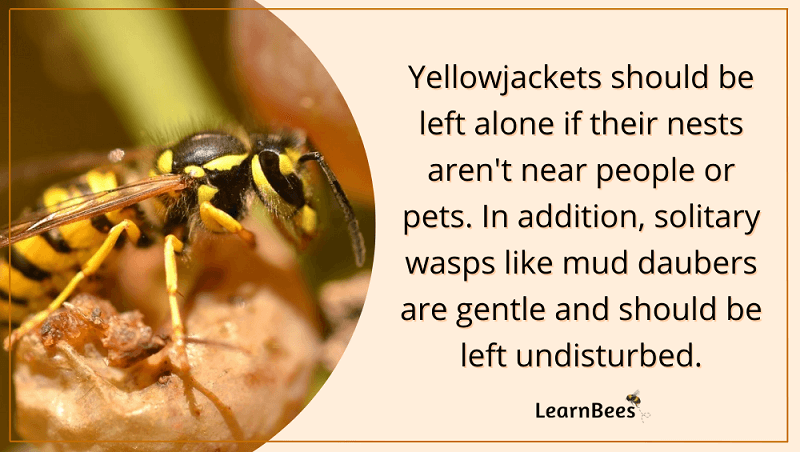
Yellowjackets are critical pollinators that help reduce pest populations by eating worms, beetles, and aphids.
If their nests are unobtrusive and avoidable, then you should leave them alone. The yellowjacket colony will die in the winter, and you can cover their nest to keep them from returning next year.
Better yet?
Sometimes nature will take care of these kinds of things.
For example, I had a yellowjacket nest in a low-traffic area of my yard. I left it alone because it wasn’t near people or pets.
Interestingly enough, though, a skunk showed up one night and destroyed the entire nest. Skunks are the main predators of yellowjacket colonies because they like to feast on both the larvae and adults.
With that in mind:
Yellowjacket colonies should be removed if they’re near unavoidable areas – especially around children and animals.
The best way to remove yellowjackets is with soap and water. Avoid using chemicals that could harm other vital pollinators. Mix dish soap in a sprayer that can attach to your hose. Yellowjackets are active during the day, so it’s best to spray their nest when they’re back home around dusk or dark.
If the colony has made a nest inside a wall of your home, then it’s wise to call pest control instead of handling it yourself.
FAQs on Black and Yellow Wasps
- What kind of wasp is black with two yellow stripes?
- Are yellowjacket wasps poisonous?
- Do black and yellow wasps pollinate?
- Are black and yellow mud daubers aggressive?
- Are black and yellow wasps a type of bee?
- What do black and yellow wasps eat?
- What do black and yellow wasps drink?
- What looks like a wasp but is black and yellow?
- Do black and yellow wasps do anything good?
- How big are black and yellow wasps?
What kind of wasp is black with two yellow stripes?
Yellowjacket wasps have black and yellow stripes that are brightly colored. Unlike bees, they have very little body hair and have thinner “wasp waists” when you look at them closely.
Other types of wasps are black and yellow, including European paper wasps and hornets.
However, European paper wasps and hornets aren’t native to the United States like yellowjackets. They were brought to the US many years ago, but they’re still not nearly as prevalent as yellowjackets.
Yellowjackets are a native wasp species commonly found throughout North America. They live in colonies, build nests underground, and rely on both flowers and insects for food. They can become protective when they feel threatened, so it’s best to give them space away from their nest.
The good news is that yellowjackets usually leave you alone if you aren’t around their nest. Yellowjacket nests should be left undisturbed if they’re not near children or animals. Their colonies will die off as winter approaches, and the queens will hibernate until spring.
You can cover the old yellowjacket nest once the weather has become cold.
—> Go back to the FAQs on black and yellow wasps
More to Explore:
- Do Wasps Make Honey?
- What’s the Difference Between Wasps, Hornets, and Bees?
- Wasp Nest vs. Bee Nest: Which One Is It?
Are yellowjacket wasps poisonous?
Yellowjacket wasps are not poisonous. Their sting contains venom, not poison.
Thankfully, most people experience a mild reaction to wasp or bee stings. There may be slight redness, irritation, and itch at the sting site area. These symptoms will subside for most within a few hours.
You can reduce sting pain by applying a cold compress (like ice) to the area for 15-20 minutes. Additionally, calamine lotion can be used to help ease itching and discomfort.
If you have a severe allergic reaction to a wasp or bee sting, then it’s essential to seek medical attention.
—> Go back to the FAQs on black and yellow wasps
More to Explore:
Do black and yellow wasps pollinate?
Yes, black and yellow wasps (yellowjackets) play a significant role in pollination. This contrasts with the mainstream narrative that these insects are aggressive and useless.
This couldn’t be furthest from the truth.
Wasps are a necessary part of healthy ecosystems. Not only do they pollinate, but they also help reduce pest populations by eating invasive insects. Farmers and gardeners can rejoice in the fact that wasps eat many bugs that attack vegetables and fruit.
Thankfully, the role wasps play in the environment is being studied more and more. The negative narrative surrounding wasps is beginning to shift to a positive one. Scientists and researchers are continuing to reveal the importance that yellowjackets and other wasps play in our ecosystems.
—> Go back to the FAQs on black and yellow wasps
More to Explore:
Are black and yellow mud daubers aggressive?
Mud dauber wasps aren’t considered aggressive. They’re solitary wasps that live alone, with each female wasp responsible for creating her own nest. As the name suggests, mud daubers build their nests using mud.
Mud daubers commonly build nests in shady areas such as porch eaves or sheds and barns. They can vary in color depending on the species, from black, to brown, to yellow and black.
—> Go back to the FAQs on black and yellow wasps
More to Explore:
Are black and yellow wasps a type of bee?
No, wasps and bees are two different insects.
Wasps belong to a group containing more than 30,000 wasp species, including yellowjackets, mud daubers, and paper wasps. Meanwhile, bees belong to a group having more than 20,000 bee species, including bumble bees, carpenter bees, and honey bees.
—> Go back to the FAQs on black and yellow wasps
More to Explore:
What do black and yellow wasps eat?
Wasps are omnivores that eat both plants and insects. They collect nectar and honeydew from flowers for carbohydrates and sugars. In terms of protein, wasps eat caterpillars, spiders, beetles, and other insects.
We can thank wasps for controlling insect populations, helping to pollinate flowers, and contributing to the health of the overall ecosystem.
—> Go back to the FAQs on black and yellow wasps
More to Explore:
What do black and yellow wasps drink?
Like bees, yellowjackets drink water to stay hydrated. They collect water from muddy puddles, flower petals, and other shallow sources.
In addition to water, yellowjackets also enjoy sugary liquids such as fruit juice and soda. This is why you have to be aware of wasps when you’re having a picnic outdoors.
—> Go back to the FAQs on black and yellow wasps
More to Explore:
What looks like a wasp but is black and yellow?
Honey bees are commonly mistaken for wasps because they’re black and yellow. However, wasps and bees aren’t the same types of insects. Honey bees are social bees that live in colonies and can make honey and beeswax. Beekeepers commonly manage them.
On the other hand, most wasps don’t produce honey or beeswax. As such, yellowjackets aren’t managed in the same way honey bees are.
—> Go back to the FAQs on black and yellow wasps
More to Explore:
Do black and yellow wasps do anything good?
Black and yellow wasps are crucial pollinators and beneficial predators. They pollinate flowers, which helps to strengthen the reproductive process of plants and trees.
Wasps also help to reduce insect populations naturally. They feast on aphids and other small bugs that can wreak havoc in gardens and farms.
—> Go back to the FAQs on black and yellow wasps
More to Explore:
How big are black and yellow wasps?
Yellowjackets are between 3/8th and 5/8th inches long. They have yellow and black marks on their abdomens that are much brighter than those of honey bees.
